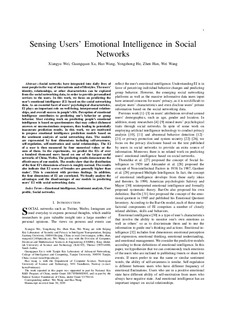| dc.contributor.author | Wei, Xiangyu | |
| dc.contributor.author | Xu, Guangquan | |
| dc.contributor.author | Wang, Hao | |
| dc.contributor.author | He, Yongzhong | |
| dc.contributor.author | Han, Zhen | |
| dc.contributor.author | Wang, Wei | |
| dc.date.accessioned | 2020-01-30T12:39:30Z | |
| dc.date.available | 2020-01-30T12:39:30Z | |
| dc.date.created | 2020-01-15T11:49:50Z | |
| dc.date.issued | 2019 | |
| dc.identifier.citation | IEEE Transactions on Computational Social Systems. 2019, . | nb_NO |
| dc.identifier.issn | 2329-924X | |
| dc.identifier.uri | http://hdl.handle.net/11250/2638880 | |
| dc.description.abstract | Social networks have integrated into the daily lives of most people in the way of interactions and of lifestyles. The users' identity, relationships, or other characteristics can be explored from the social networking data, in order to provide personalized services to the users. In this article, we focus on predicting the user's emotional intelligence (EI) based on social networking data. As an essential facet of users' psychological characteristics, EI plays an important role on well-being, interpersonal relationships, and overall success in people's life. Perception of EI contributes to predicting one's behavior or group behavior. Most existing work on predicting people's EI is based on questionnaires that may collect dishonest answers or unconscientious responses, thus leading in potentially inaccurate prediction results. In this article, we are motivated to propose EI prediction models based on the sentiment analysis of social networking data. The models are represented by four dimensions, including self-awareness, self-regulation, self-motivation, and social relationships. The EI of a user is then measured by four numerical values or the sum of them. In the experiments, we predict the EIs of over a hundred thousand users based on one of the largest social networks of China, Weibo. The predicting results demonstrate the effectiveness of our models. The results show that the distribution of the four EI's dimensions of users is roughly normal. The results also indicate that EI scores of females are generally higher than males' EI scores. This is consistent with previous findings. In addition, the four dimensions of EI are correlated. We finally analyze the advantages and the disadvantages of our models in predicting users' EI with social networking data. | nb_NO |
| dc.language.iso | eng | nb_NO |
| dc.publisher | Institute of Electrical and Electronics Engineers (IEEE) | nb_NO |
| dc.title | Sensing Users' Emotional Intelligence in Social Networks | nb_NO |
| dc.type | Journal article | nb_NO |
| dc.type | Peer reviewed | nb_NO |
| dc.description.version | acceptedVersion | nb_NO |
| dc.source.pagenumber | 10 | nb_NO |
| dc.source.journal | IEEE Transactions on Computational Social Systems | nb_NO |
| dc.identifier.doi | 10.1109/TCSS.2019.2944687 | |
| dc.identifier.cristin | 1773558 | |
| dc.description.localcode | © 2019 IEEE. Personal use of this material is permitted. Permission from IEEE must be obtained for all other uses, in any current or future media, including reprinting/republishing this material for advertising or promotional purposes, creating new collective works, for resale or redistribution to servers or lists, or reuse of any copyrighted component of this work in other works. | nb_NO |
| cristin.unitcode | 194,63,10,0 | |
| cristin.unitname | Institutt for datateknologi og informatikk | |
| cristin.ispublished | false | |
| cristin.fulltext | postprint | |
| cristin.qualitycode | 1 | |
